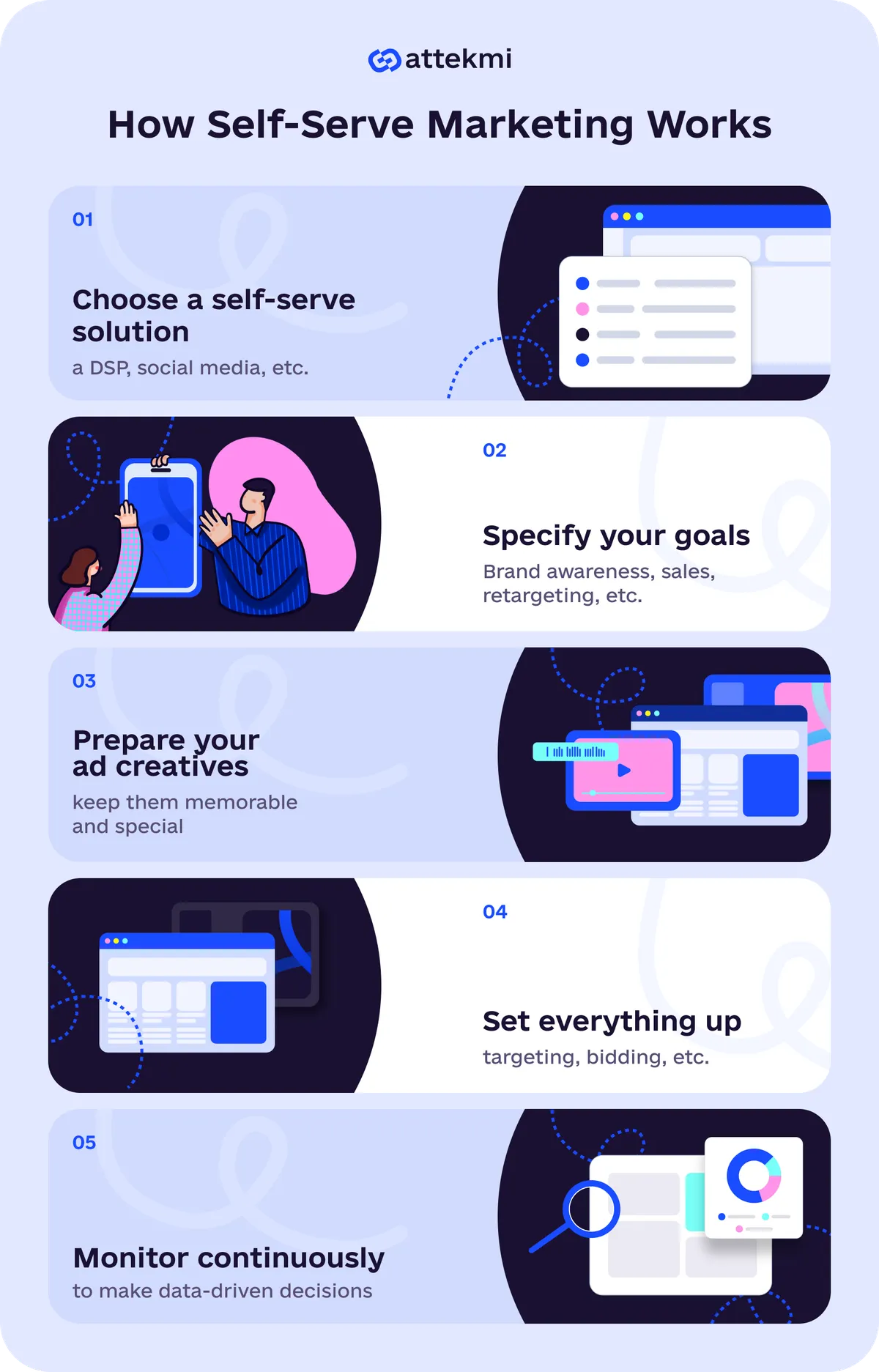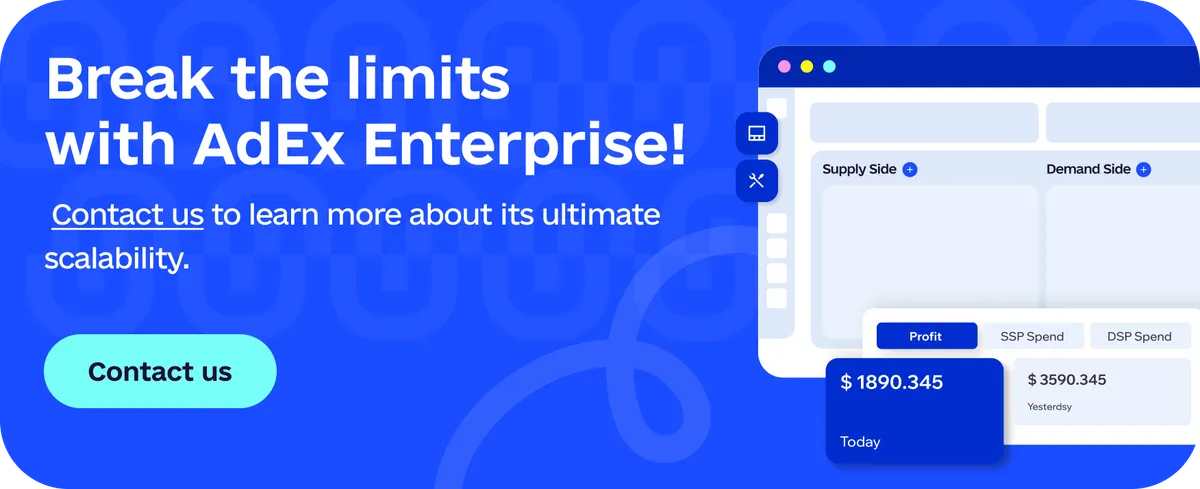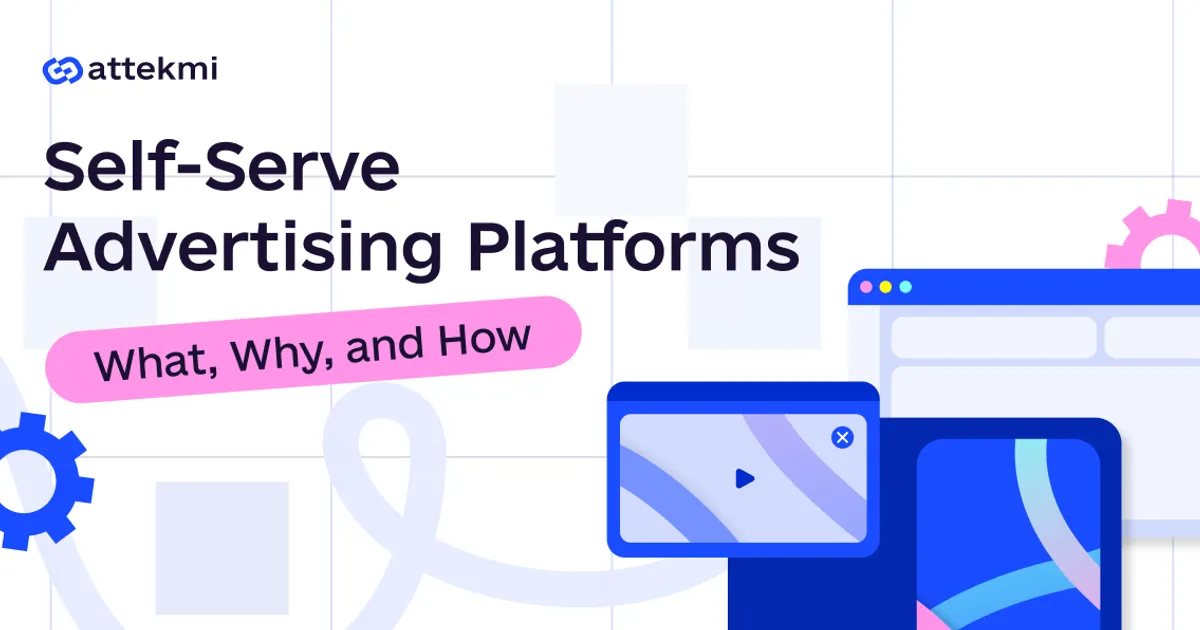Modern digital advertisers benefit from an impressive variety of marketing opportunities – there are a lot of different platforms that enable them to reach their audiences in an effective way. Many of these solutions operate according to the self-serve model, however, not every advertiser knows what this means.
The definition may seem straightforward, but what about other aspects? What features should a self-service platform have and how to build it? Our guide is here to answer these and other questions, so keep reading to learn more.
What is a self-serve advertising platform?
Let’s start with clarifying the meaning of a self-service advertising platform. So, such a platform is an AdTech solution that enables marketers to create, launch, and manage campaigns independently.
For instance, many demand-side platforms offer both options to choose from. In the case of self-service ads, you keep everything under your total control and are responsible for managing your marketing efforts. In turn, if you prefer managed services, the team of a DSP sets your ads up for you.
How does a self-serve advertising platform work?
If you are not new to digital advertising, you are most likely familiar with the working principles of a self-serve platform. However, you could still miss some nuances, so let’s explore them.
So, a self-serve platform for advertisers integrates with other systems like demand- and supply-side platform (DSP and SSP), data management platform (DMP), customer data platform(CDP), ad server, and ad network. Once you create a campaign, the information is passed to these AdTech solutions via an application programming interface (API). If you make any changes utilizing your self-serve platform, the information is updated automatically, which ensures smooth campaign management.
As for the process of launching campaigns via such a platform, here are the steps you need to take.
Choose a self-serve solution
The first thing to do is to select a platform (or platforms, which can help you extend reach). For instance, these can be social networks like LinkedIn or Instagram, a DSP, etc. When choosing a solution, learn everything about its features and check how often it is updated with new functionalities. If you are a publisher, you need to choose an SSP to manage your ad inventory.
Specify your goals
Your campaign needs clear objectives – otherwise, you will act blindly. For example, you may want to increase brand awareness, drive sales, or focus on retargeting campaigns. Make sure to keep your goals SMART: specific, measurable, achievable, relevant, and time-bound. Otherwise, it will be challenging for you to measure your success.
Prepare your ad creatives
Then, decide on the format and prepare creatives for your campaign. Do not forget to follow creative specifications, if necessary. Besides, your ads must be catchy and memorable to draw customer attention and build brand awareness effectively.
Set everything up
The next step is to focus on targeting, bidding, and other settings. Again, it is crucial to know everything about your platform’s functionalities. With this knowledge in mind, you will be able to make the most of your campaigns.
Monitor continuously
Regardless of the selected platform, you need to track the performance of your campaigns continuously. This will allow you to detect both weaknesses and opportunities on time and, as a result, make data-driven decisions on how to optimize your strategy.

What are the key features of self-serve ad platforms?
Now let’s review the main features a solution based on a self-serve advertising technology should have. An intuitive and convenient user interface is a must, but there are more things to pay attention to when choosing or building such a platform.
Campaign management functionalities
These are all the features related to creating, launching, and adjusting the campaigns. For instance, these can be supported formats and traffic types, targeting and bidding settings, scheduling functionalities, various filters, and so on.
Budget optimization features
An effective platform should enable you not only to set up your bids. Additionally, it should have features that will help you prevent overspending and adjust your bids to the most optimal level. Besides, check if your potential solution has functionalities for enhancing your campaign performance.
Integrations
Integrations with other AdTech platforms like ad servers, ad networks, SSPs, and others, are another core feature to consider. The same applies to data platforms – connections with them can help you reach specific target audiences.
User management capabilities
Besides, an effective self-serve advertising platform should be equipped with user management features so that you will be able to add other users (and remove them, when necessary), specify their access rights, etc.
Analytics features
Effective marketing relies on analytics, so an advertising solution must have advanced analytics capabilities. Apart from providing information about key metrics like clicks, conversions, and others, a platform should collect additional insights based on such factors as ad format, location, and others. Besides, when choosing or building a platform, make sure that an analytics dashboard is convenient to interact with. All the information should be available in one place, and users should be able to customize the reports according to their needs.
Benefits of building your own self-serve ad platform
The market offers an impressive variety of self-serve platforms to choose from. Basically, it can meet any needs. However, in certain cases, building such a solution is more beneficial than using an already existing one.
For instance, for AdTech businesses, enterprises, and medium and large media companies, creating a self-serve platform can be a way to go. At the same time, small companies often prefer renting such an advertising platform since this implies lower expenses and the ability to start launching campaigns straightaway.
Yes, development from scratch can be pretty expensive and time-consuming. It requires specific experience and skills, and you may still face some bugs and errors after the platform launch. However, building an advertising solution still has several significant benefits.
The solution will have all the features you need
When building your own platform, you decide on the functionalities, interface, and design it will have. You can tailor your solution to your specific required and then update it with new capabilities when necessary – there is no need for you to wait until a vendor upgrades a platform.
You have full control over the process
Apart from this, you will have complete control over the development process, as well as the product roadmap. You decide both on short and long-term goals, identify priorities, and so on. Note that it is essential to ensure flexibility – you should be ready to adapt to the market and any other potential changes quickly.
You will have 100% ownership
Last but not least, you will be the owner of the platform, its technology, and its data. Apart from using your solution on your own, you will also be able to offer it to other companies and drive income.
How to build a self-serve advertising platform
While building a self-serve solution is basically a software development project, it still requires solid knowledge of the AdTech industry – if you lack it, it may be challenging for you to decide on the right functionalities and make your product competitive. Therefore, it may be essential for you to hire an expert (or experts) who have experience in building such platforms.
As for the key stages of the development process, they are as follows:
Conduct initial research and identify the requirements
First and foremost, you should identify the vision, context, and goals of your project. Besides, research the already existing platforms to understand how you can outperform your competitors. Deciding on the initial requirements and potential challenges is essential as well.
This phase plays a crucial role since it enables you to understand if you actually need this solution and whether you can afford to build it from scratch.
Focus on technical research
Then, you need to dive deep into the technical aspects. Identify technical unknowns, look for possible solutions, finalize the list of features for an MVP, and come up with a set of tasks. Apart from this, research and decide on the optimum infrastructure architecture and tech stack.
Build an MVP
After this, focus on building a minimum viable product (MVP), including backend, frontend, design, etc. Thorough testing should be a part of the process as well. When your MVP is ready, launch it for initial users and monitor its performance continuously to be able to react to potential issues on time. Make sure to gather feedback from other users to understand what can be improved.
Maintain your platform
Finally, prioritize ongoing support and maintenance to ensure the effective performance of your solution. Remember that to keep your solution competitive, you will have to upgrade it with new features regularly. If you are going to offer it to other companies, gather feedback from them to understand what functionalities to focus on.

Join the AdTech industry with ad exchange solutions from Attekmi! Contact us to learn more.
Future trends in self-service advertising
Investments in programmatic marketing keep growing, so we can expect an increasing number of self-serve programmatic advertising platforms. However, this is not the only trend to consider when choosing or building a solution. Here are several more projections for you to consider.
Increasing impact of AI:
Artificial intelligence has revolutionized multiple industries, including AdTech, and its impact is still evolving. While currently we can benefit from such applications as dynamic creative optimization, predictive analytics, real-time optimization, and others, we can expect AI to play an even greater role in campaign management in the future. However, it is important to remember that the human touch is still required in many cases – for instance, any generated ad copy or creative should be reviewed.
Regulations are getting stricter:
Reflecting the growing concerns of users regarding their online privacy, international privacy regulations and data processing standards are getting more and more stricter. Therefore, it is important for you to monitor the evolving rules and make sure that your solution is compliant with them.
Additionally, if you have not switched from third-party cookies to alternative methods yet, now is the time to do this. Cookies are still in use, but they will be eliminated, and it is better to get ready for this in advance – this will provide you with a competitive advantage.
The rise of DOOH and audio advertising:
Digital out-of-home (DOOH) and audio ads are gaining momentum – advertisers are looking for additional ways to create an omnichannel experience for their audiences and reach them with creative formats. Many programmatic platforms enable you to launch such campaigns, so consider experimenting with them to understand their impact.
In case you are planning to build your own self-serve platform, DOOH and audio formats may not be among the first key features to implement, but you may want to add them at some point later. This will provide you and your platform users with greater flexibility.
Consider Attekmi your trusted partner
There are a lot of platforms available in the market: self-serve ad networks, DSPs, social networks, etc. While some of them enable advertisers to launch their campaigns, others allow you to earn on media trading – like ad exchange solutions from Attekmi.
Our range of ad exchange platforms is able to meet the needs of any business:
AdEx Basic: an entry-level do-it-yourself platform designed for businesses only entering the industry.
AdEx Plus: an advanced version of AdEx Basic.
AdEx Enterprise: an ultimately scalable platform providing access to a full range of features (new functionalities are on the way).
White Label Ad Exchange: a fully customizable solution, from UI personalization to custom on-request feature development.
Additionally, we offer AdTech custom development, Ad Ops outstaffing, and Ad Ops training services. Therefore, if you are going to develop your own self-serve solution, our knowledge, skills, and experience can help you bring your project to life with maximum efficiency.
We are your trusted partner in any AdTech matter and are ready to help you start earning on media trading, create a unique product, enhance your knowledge, and not only.
Contact us to learn more!
 By Anastasiia Lushyna
By Anastasiia Lushyna
